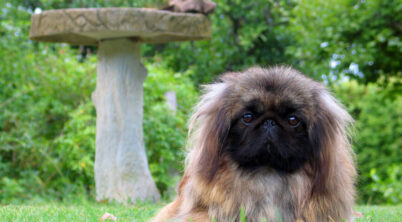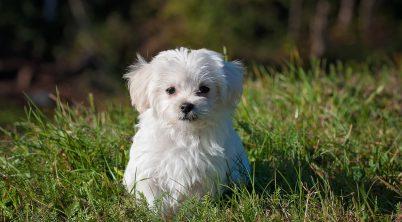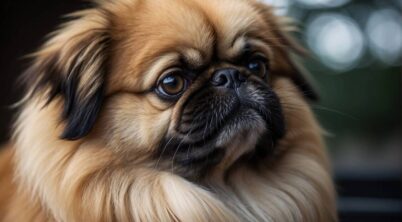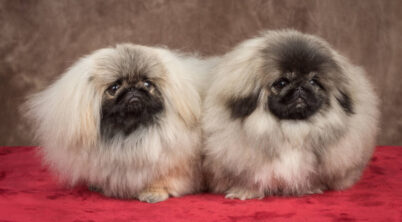The Pekingese, with its distinctive lion-like appearance and regal demeanor, is a toy breed that has captured the hearts of dog enthusiasts for centuries. Originating from China, these small dogs are known for their long, flowing coats and short-muzzled face. Despite their noble lineage, Pekingese are prone to several health problems that owners should be aware of. Being brachycephalic, or having a “pushed-in” face, they are susceptible to respiratory issues along with a host of other medical concerns that require vigilant care and regular veterinary oversight.
Skin conditions are among the most common ailments affecting the Pekingese. Factors contributing to these issues range from parasites and allergies to infections, leading to symptoms like excessive scratching, hair loss, and inflammation. Furthermore, the characteristic large, protruding eyes of the Pekingese are vulnerable to injury and disease, including corneal ulcers and dry eye. Prospective and current owners should be prepared to manage these conditions with a combination of preventative care and treatment strategies recommended by a veterinarian.
Other notable health problems that may affect Pekingese include hernias, bloat, and autoimmune hemolytic anemia. While some of these conditions can be managed with proper care and medical attention, others, such as hernias, might require surgical intervention. To minimize the risk of serious complications, it is important for Pekingese owners to maintain regular veterinary appointments. Early detection and prompt treatment are crucial in preserving the well-being of these cherished companions.
Table of Contents
Breed Overview
The Pekingese is a toy breed with a history that intertwines with Chinese royalty and a personality befitting its noble lineage. They are known for their distinct physical attributes and a temperament that reflects their history as a favored companion of imperial China.
History and Origin
The Pekingese breed hails from the ancient city of Peking, now known as Beijing, China. Their storied history began over 2,000 years ago as revered companions to Chinese emperors and their families. Legend has it that the breed was created by the Buddha, shrinking lions to a smaller size. The Pekingese rose to prominence in the Western world after several dogs were taken from the Summer Palace during the Second Opium War and one was presented to Queen Victoria, leading to the breed’s global admiration. Its status was further cemented when recognized by the American Kennel Club (AKC) in 1906.
Physical Characteristics
The Pekingese possesses a distinctive lion-like appearance highlighted by a broad, flat face and a well-proportioned, compact body. An opulent double coat, which comes in various colors and patterns, requires regular grooming. Notably, their short muzzle places them within the brachycephalic breeds, making them susceptible to respiratory issues.
Height: 6-9 inches
Weight: 7-14 pounds
Coat Type: Long, double-coated
Eye Shape: Large, round
Tail: High curled over back
Personality Traits
Pekingese are charming and confident, often described as having a ‘big dog’ demeanor. They tend to form strong bonds with their family members, reflecting their heritage as devoted lap dogs to royalty. This dignified breed may exhibit wariness around strangers, a trait that can serve them well as watchful companions. They require early socialization to foster a well-rounded temperament, particularly to mitigate any potential for aggressive behavior towards other animals.
Common Health Issues
The Pekingese breed is predisposed to a variety of health conditions, largely due to their distinctive physical characteristics. Owners should pay particular attention to issues related to their respiratory and skeletal systems, eyes, heart, skin, and dental health.
Respiratory Conditions
The Pekingese is brachycephalic, meaning they have a short skull and snub nose, which can lead to breathing difficulties and snoring. Conditions like stenotic nares and elongated soft palate are common. Owners should be vigilant for signs of distress or labored breathing, especially in hot weather or during exercise.
Eye Conditions
Due to their prominent eyes, Pekingese are at risk of several eye issues:
- Progressive Retinal Atrophy (PRA): This degenerative condition leads to blindness.
- Corneal Ulcer: Resulting from scratches or trauma due to bulging eyes.
- Cataracts: Can lead to impaired vision and eventual blindness.
- Cherry Eye: Involves prolapse of the third eyelid, leading to red, swollen eye appearance.
Orthopedic Concerns
Pekingese can suffer from several orthopedic conditions due to their unique body structure:
- Arthritis: Common in older Pekingese, causing pain and mobility issues.
- Hip Dysplasia and Patellar Luxation: Can cause lameness and affect mobility.
- Disk Disease, specifically Intervertebral Disk Disease (IVDD): A serious condition affecting their spinal cord, leading to pain, paralysis, or neurological problems.
Heart Problems
Cardiac issues are not uncommon in the breed, with Mitral Valve Disease being a notable risk. It can lead to heart failure if not diagnosed and managed early.
Dermatological Issues
Skin health is a concern for Pekingese, with the potential for:
- Skin Infections: Often a result of allergies, parasites, or folds in the skin.
- Ear Infections: The breed’s heavy coat and ear structure can encourage infections.
Dental Concerns
Due to their small mouths, Pekingese often face dental disease, which can lead to tooth loss and systemic health issues if not properly cared for. Regular dental check-ups and cleanings are essential.
Genetic Predispositions
The Pekingese breed, with its distinctive characteristics, is subject to various genetic predispositions that can impact their health. These genetic traits can lead to inherited disorders and breed-specific ailments, affecting their quality of life.
Inherited Disorders
Inherited health issues are passed down through the Pekingese gene pool. One of the more serious conditions that can be inherited is Progressive Retinal Atrophy (PRA). PRA is an eye disorder that gradually deteriorates the retina, potentially leading to blindness. Genetic testing can help identify carriers of the PRA gene.
Another inherited condition that affects Pekingese is Hip Dysplasia. This malformation of the hip joint can lead to pain, arthritis, and mobility issues. Though more common in larger breeds, Pekingese can also suffer from this hereditary condition.
Breed-Specific Ailments
Pekingese dogs often face breed-specific health problems due to their unique physique. They are prone to Intervertebral Disk Disease (IVDD), where the disks that cushion the vertebrae can herniate or degenerate, leading to pain, nerve damage, and paralysis. The long back and short legs characteristic of the Pekingese breed contribute to the prevalence of this condition.
| Breed-Specific Condition | Description |
|---|---|
| IVDD | A spinal condition often resulting from the breed’s physical structure, leading to back pain and potential paralysis. |
| Hip Dysplasia | Despite their small size, Pekingese can inherit this joint issue, which can compromise their mobility. |
Early diagnosis and management are crucial for Pekingese suffering from these genetic predispositions, with the aim of maintaining their well-being and prolonging a healthy life.
Diet and Nutrition
Proper nutrition plays a crucial role in the health and well-being of Pekingese dogs. They require a balanced diet that meets their specific needs, which includes the appropriate amount of proteins, fats, carbohydrates, vitamins, and minerals. Given their small size, they generally consume about 1/2 to 1 cup of dry food per day, divided into two meals.
Obesity is a notable concern for the Pekingese breed. They can easily gain excessive weight if their caloric intake exceeds their energy expenditure. Contributing factors can be:
- Overfeeding: Providing more food than necessary.
- Genetic predisposition: Some Pekingese may have a natural propensity to gain weight.
- Lack of physical activity: Insufficient exercise can lead to weight gain.
Maintaining a healthy weight is essential for Pekingese. A heavyset Pekingese may face increased risks of:
- Heart disease,
- Joint problems,
- Respiratory difficulties.
Owners should adhere to the feeding guidelines on the dog food packaging and adjust portions according to the dog’s:
- Age,
- Activeness,
- Overall health.
Here is a sample diet outline for a Pekingese:
- Morning meal: 1/4 to 1/2 cup of dry dog food.
- Evening meal: 1/4 to 1/2 cup of dry dog food,
- Plus, sufficient water all day.
A veterinarian or a canine nutritionist can offer personalized advice tailored to an individual Pekingese’s dietary requirements, ensuring a diet that supports their health without leading to unnecessary weight gain.
Lifestyle Needs
The Pekingese breed has distinct lifestyle requirements to maintain their well-being, including appropriate exercise and meticulous grooming routines.
Exercise and Activity Requirements
Exercise: Despite their small stature, Pekingese dogs require regular exercise to prevent obesity and promote cardiovascular health. Due to their short legs and flat faces, intense exercise is not recommended; instead, they thrive on short, gentle walks and play sessions.
- Daily Routine: A consistent exercise routine should include multiple brief walks each day coupled with playtime to keep them active without overexertion.
- Well-Being: Mental stimulation through exercise and play is crucial for the Pekingese, promoting both physical well-being and behavioral health.
Grooming and Care
Grooming: Pekingese dogs have a long, flowing coat that demands regular grooming to prevent tangles and mats.
- Brushing: Daily brushing is essential. It not only maintains the coat’s cleanliness and luster but also serves as a bonding activity between the dog and its owner.
- Professional Grooming: Occasional visits to a professional groomer are recommended to ensure their coat is trimmed properly, especially around the face to prevent eye irritation.
Regular grooming is vital for the Pekingese, as it prevents skin infections and enhances their overall comfort, keeping them happy and healthy.
Preventative Measures
Proactive care is essential in mitigating health issues for Pekingese dogs. This section outlines key preventative strategies to ensure their well-being.
Regular Veterinary Visits
Veterinary check-ups are pivotal in the early detection and prevention of health problems in Pekingese. Owners should schedule regular visits to the vet, ideally bi-annually, to monitor their dog’s health and to catch any potential issues early. During these visits, vets can provide advice on weight management and exercise — two factors critical in preventing common Pekingese health issues like obesity and back problems.
Vaccinations and Parasite Control
Keeping up with the recommended vaccination schedule is vital to protect Pekingese from infectious diseases. Comprehensive parasite control, which includes regular treatments for fleas, ticks, and worms, is equally important. Neutering or spaying can also prevent certain health issues. A regular vaccine and parasite control regimen, tailored to each individual Pekingese by their vet, builds a solid foundation for their long-term health.
Behavioral Aspects
Pekingese dogs possess a unique blend of independence and loyalty, characteristics that can influence their behavior. Trainers and breed consultants often emphasize the importance of acknowledging their sensitive nature during training and socialization.
Training Challenges
The Pekingese may exhibit stubbornness during training sessions, requiring a patient and consistent approach from dog trainers. It is crucial to use positive reinforcement and establish reliable communication. Training centers might suggest:
- Commands such as “sit” or “stay” to redirect attention.
- Offering rewards for desired behaviors to encourage cooperation.
Their independent streak means they may not always respond to commands immediately, reinforcing the need for persistent and adaptive training methods.
Socialization and Temperament
Socialization is essential for Pekingese to cultivate a well-balanced temperament. They are inherently loyal to their family but may be wary of strangers, which can make them effective watchdogs. Key considerations include:
- Introducing the Pekingese to various environments and people to reduce fearfulness.
- Ensuring positive interactions with other pets early on to mitigate dominance issues.
By understanding and catering to the Pekingese’s personality, owners can foster a congenial social demeanor, enabling these dogs to become more adaptable to different scenarios and company.
Living with a Pekingese
Living with a Pekingese brings a unique set of challenges and rewards. They are long-standing companions often cherished for their distinct personality and regal heritage.
Family Integration A Pekingese may thrive in a family environment, with their loyal and affectionate demeanor towards their owners. However, families with small children should be cautious. The breed can be delicate and may not tolerate rough handling, making early socialization and education for children on how to properly interact with the dog essential.
Exercise Needs While they enjoy being active within the home, Pekingese do not require extensive outdoor exercise. Short daily walks are sufficient to keep them healthy. This breed’s small size and moderate activity level make them suitable for both apartment living and homes with yards.
Socialization Pekingese tend to be reserved around strangers. Owners should gently expose them to a variety of people, places, and situations to ensure they become well-adjusted adults. Positive, patient training can facilitate their social development.
Table: Pekingese Interaction and Activity Guide
| Aspect | Consideration |
|---|---|
| Children | Supervise interactions, teach gentle play |
| Family | Loving, loyal, better with older or considerate members |
| Active | Enjoy being part of family activities |
| Exercise | Short daily walks, indoor play |
| Socialization | Early exposure to diverse environments, positive reinforcement |
Their compact size and relatively modest exercise needs do not diminish their spirited nature. Owners should invest time in proper training and socialization to ensure their Pekingese’s well-being and develop a mutually respectful relationship.
Emergency Care and Conditions
When a Pekingese encounters a serious health issue or emergency situation, recognizing the signs and responding promptly is crucial. Owners should be informed about the basics of emergency care and understand when to seek immediate veterinary intervention.
Recognizing Serious Health Issues
It is vital for Pekingese owners to be aware of symptoms that may indicate a serious condition requiring urgent attention. Paralysis, for instance, can be a sign of a severe neurological issue or spinal injury and demands immediate veterinary assessment. Respiratory signs, including snorting, snuffling, or sneezing, may signal brachycephalic airway syndrome and can lead to life-threatening complications if not treated swiftly. Blindness—whether sudden or progressive—is another significant condition that can affect Pekingese dogs, often requiring specialized care from a veterinarian.
First Aid and Emergency Situations
In any emergency, stabilizing the dog before transport to a vet is essential. Here are some key first aid steps:
- Heat Stroke: Apply cool water to your Pekingese’s body and offer small amounts of water to drink.
- Respiratory Distress: Keep the dog calm and cool; avoid stress which could exacerbate breathing issues.
| Condition | Symptoms | Immediate Action | Vet Intervention |
|---|---|---|---|
| Paralysis | Inability to move limbs | Immobilize and transport with care | Necessary for diagnosis & treatment |
| Breathing Problems | Snorting, Snuffling | Ensure open airway, keep calm and cool | Essential for respiratory support |
| Sudden Blindness | Bumping into objects | Prevent injury, no sudden movements | Required for assessment & management |
| Heat Stroke | Excessive panting | Cool down gradually, offer water | Urgent to prevent organ damage |
An owner’s ability to identify these emergencies and act accordingly can make a significant difference in the outcomes for a Pekingese in distress. Immediate veterinary attention is often crucial and can save a dog’s life in these acute situations.
* Banner photo by jen, cropped | Some rights reserved








